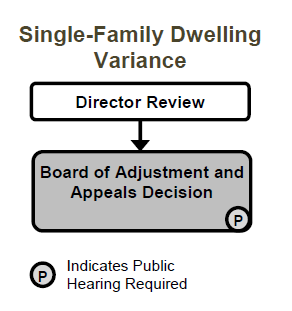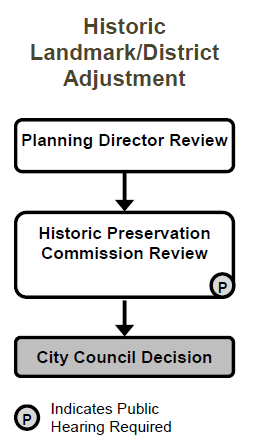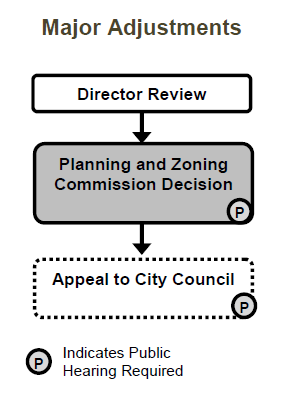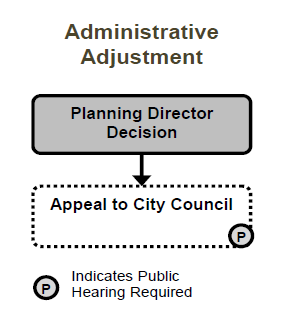5.4.4. FLEXIBILITY AND RELIEF PROCEDURES.
A. Hardship Variance. All applicable provisions of Section 146-5.3 (Common Procedures) apply unless specifically modified by the provisions of this Section 146-5.4.4.A.
1. Applicability.
a. This Section 146-5.4.4.A applies to all requests for variances from the standards and provisions of this UDO that do not meet the criteria for approval under any other flexibility and relief procedures in Section 146-5.4.4.
b. Hardship Variances under this Section 146-5.4.4.A may not be approved in the APZ I or II zone district.

2. Procedure.
a. The Planning Director shall review the application and forward a recommendation to the Board of Adjustment and Appeals pursuant to all applicable provisions of Section 146-5.3 (Common Procedures).
b. The Board of Adjustment and Appeals shall conduct a public hearing on the application and shall make a decision on the application pursuant to all applicable provisions of Section 146-5.3.
3. Criteria for Approval. An application for a general Hardship Variance shall be approved if the Board finds that all of the following criteria have been met.
a. The Hardship Variance is necessary because literal enforcement of the provisions of this UDO will result an unnecessary, and unreasonable hardship to the applicant caused by a unique site condition that is not generally applicable to other lots in the surrounding area; and
b. The need for the Hardship Variance was not knowingly created or created without investigation of UDO provisions by the owner, lessor, or operator of the property; and
c. The grant of the Hardship Variance will not injure the appropriate use of, or the supply of light and air to, adjacent conforming property within the same zone district; and
d. The effect of the granting the Hardship Variance is to allow the applicant development potential similar to, but not greater than, other lots in the same zone district in the surrounding areas.
4. Resubmittal. An application for a Hardship Variance that the Board of Adjustment and Appeals has denied or approved with conditions shall not be resubmitted within one year after such decisions unless a substantial change in the first application has been made, as determined by the Board.
B. Single-Family Dwelling Variance. All applicable provisions of Section 146-5.3 (Common Procedures) apply unless specifically modified by the provisions of this Section 146-5.4.4.B.

1. Applicability. This Section 146-5.4.4.B applies to all applications for a variance from the standards and of provisions of this UDO or to the provisions of Chapter 90 as they relate to the modification of an existing single-family dwelling or the lot on which it is located that do not qualify for approval as a Minor Amendment under Section 146-5.3.15.A. This section may not be used to vary the standards or provisions of this UDO for single-family homes that have not yet obtained a certificate of occupancy or Manufactured Homes that have not yet been installed in accordance with Chapter 90.
2. Procedure.
a. Planning Director shall review the application and forward a recommendation to the Board of Adjustment and Appeals pursuant to all applicable provisions of Section 146-5.3 (Common Procedures).
b. The Board of Adjustment and Appeals shall conduct a public hearing on the application and shall make a decision on the application pursuant to all applicable provisions of Section 146-5.3.
3. Criteria for Approval. An application for a single-family dwelling variance shall be approved if the Board finds that the proposed variance will not adversely affect adjacent properties or the surrounding neighborhoods and a majority of the following criteria have been met:
a. The proposed variance results in improved design.
b. The proposed variance does not adversely affect the character of lower density residential areas.
c. The proposed variance will result in development that is compatibility with adjacent land development.
d. The proposed variance will not result in undue or unnecessary burdens on existing infrastructure and public improvements, or arrangements have been made to mitigate those impacts.
e. The proposed variance results in development that achieves internal efficiency for its residents and does not endanger public health or convenience.
f. The proposed variance results in development that controls external effects on nearby land uses, movement and congestion of traffic, noise generated, arrangement of signs and lighting to prevent nuisances, landscaping, and features to prevent detrimental impacts on public health, welfare, safety or convenience.
4. Resubmittal. An application for a Single-family Dwelling Variance that the Board of Adjustment and Appeals has denied or approved with conditions shall not be resubmitted within one year after such decisions unless a substantial change in the first application has been made, as determined by the Board.
C. Historic Landmark and District Adjustments. All applicable provisions of Section 146-5.3 (Common Procedures) apply unless specifically modified by the provisions of this Section 146-5.4.4.C.

1. Applicability. This Section 146-5.4.4.C applies to all requests for deviations from standards applicable to landmarks, landmark sites, and historic districts pursuant to 146-2.6.5 (Historic Protection Overlay (-HPO)) or standards adopted by the Historic Preservation Commission pursuant to that Section, or to other provisions of this UDO applicable to those landmarks, landmark sites, or historic districts.
2. Procedure.
a. The Planning Director shall review the application and forward a recommendation to the Historic Preservation Commission pursuant to all applicable provisions of Section 146-5.3 (Common Procedures).
b. The Historic Preservation Commission shall hold a public hearing and shall make a recommendation to City Council regarding the application pursuant to all applicable provisions of Section 146-5.3.
c. The City Council shall make a decision on the application pursuant to all applicable provisions of Section 146-5.3.
3. Criteria for Approval. A Historic Landmark/District Adjustment shall only be recommended for approval or shall only be approved if the Council determines that:
a. The adjustment allows a building or site feature that would not be permitted under this UDO but is necessary to preserve the historic character or significance of the affected building, site, or district, and is subject to the same protections and guidelines apply to the remainder of the building or site.
b. The adjustment is drafted to expire at the time the use that created the need for the adjustment or the historical character of the item changes or ceases.
c. The owners or managers of property containing building or site feature permitted by the adjustment have agreed in writing to paint, repair, and otherwise refurbish the permitted features to keep them in good repair and working order, and that failure to maintain the feature may cause the adjustment to be revoked.
D. Major Adjustments. All applicable provisions of Section 146-5.3 (Common Procedures) apply unless specifically modified by the provisions of this Section 146-5.4.4.D.

1. Applicability. This Section 146-5.4.4.D applies to all applications requesting an adjustment to the Development Standards in this UDO, except those involving an existing single-family dwelling and/or the lot on which it is located, that do not meet the applicability criteria for an Administrative Adjustment or Federal Fair Housing Adjustments and do not meet the applicability criteria for a Hardship Variance under Section 146-5.4.4.A.
2. Procedure.
a. The Planning Director shall review the application and forward a recommendation to the Planning and Zoning Commission pursuant to all applicable provisions of Section 146-5.3 (Common Procedures).
b. The Planning and Zoning Commission shall conduct a public hearing on the application and shall make a decision on the application pursuant to all applicable provisions of Section 146-5.3.
3. Criteria for Approval.
a. The adjustment will have no material adverse impact on any abutting lot, or any material adverse impacts have been mitigated by conditions attached to the adjustment; and
b. The adjustment does not violate any conditions of approval specifically applied to development of the property by the Planning and Zoning Commission or City Council; and
c. At least one of the following criteria have been met:
i. The adjustment will result in a perception of development quality as viewed from adjacent streets and abutting lots that is equal to or better than would have been required without the adjustment.
ii. The adjustment will provide options for a more connected neighborhood layout or, for an adjustment for a residential subdivision, the adjustment will result in a neighborhood layout and level of multi-modal connectivity equal or better than would have been required without the adjustment.
iii. The adjustment will result in equal or better screening and buffering of adjacent properties and ground and roof mounted equipment than would have been required without the adjustment.
iv. The adjustment will not result in a material increase in on-street parking or traffic congestion on any local street in any Residential zone district within 200 feet of the applicant’s site; and
v. For an adjustment to the maximum number or area of signs or sign setbacks, the adjustment will have a minimal visual effect on the surrounding neighborhood, and is necessary to compensate for unusual shape or orientation of the lot or to allow sign visibility comparable to, but not exceeding, that available to nearby lots of approximately the same size and shape in the same zone district.
E. Federal Fair Housing Adjustments. All applicable provisions of Section 146-5.3 (Common Procedures) apply unless specifically modified by the provisions of this Section 146-5.4.4.E.

1. Applicability. This Section 146-5.4.4.E applies to all requests that the City provide “reasonable accommodation” or “reasonable modifications” to the provisions of this UDO pursuant to the federal Fair Housing Amendments Act of 1988.
2. Procedure. The Planning Director shall review and make a decision on the application.
3. Criteria. A Federal Fair Housing Adjustment shall only be approved if the Planning Director determines that the adjustment is the minimum change from the provisions of this UDO necessary to comply with the requirements of the federal Fair Housing Act Amendments of 1988 and that the adjustment will not cause a material adverse impact on the surrounding area. The Director shall not be required to approve, approve with conditions, or deny the requested adjustment, but may approve a different adjustment that meets the criteria in the previous sentence.
F. Administrative Adjustments. All applicable provisions of Section 146-5.3 (Common Procedures) apply unless specifically modified by the provisions of this Section 146-5.4.4.F. Decisions to approve an Administrative Adjustment are not appealable, but the decision or approval that includes an Administrative Adjustment is appealable pursuant to Section 146-5.3.13 (Appeals).

1. Applicability.
a. This Section 146-5.4.4.F authorizes the Planning Director to make administrative adjustments to those development standards listed below as part of other development approvals and applications under this UDO.
|
Table 5.4-1 Administrative Adjustments |
|
|---|---|
|
Ordinance Standard |
Amount of Variation Permitted from Ordinance Standard |
|
All Permits and Approvals |
|
|
Maximum or minimum building setbacks |
10% |
|
Maximum building height |
5% in Residential districts; 10% in other districts |
|
Maximum height of fence or wall |
10% |
|
Minimum off-street parking required or maximum off-street parking permitted |
5% in Residential districts; 10% in other districts |
|
Additional for Redevelopment Plans |
|
|
Any development standard in Article 146-5 |
The minimum amount needed to allow redevelopment of the property given the location of lawfully existing buildings and structures that will remain after redevelopment. |
|
Additional for Signs |
|
|
Maximum total sign area |
10% |
|
Maximum number of signs |
2 additional for large scale retail single-tenant use (over 50,000 sq. ft. 1 additional sign for all other uses |
|
Additional for Fences |
|
|
Location, setback, or height of fences constructed under the Neighborhood Fence Replacement Program |
As necessary to allow the replacement fence to comply with requirements of the Neighborhood Fence Replacement Program |
|
Additional for Existing Single-Family Property |
|
|
Setbacks |
10% |
|
Fences |
10% |
|
10% |
|
|
Additional for Infill Development in Subarea A and –HSO Zone District |
|
|
Any dimensional standard or design standard related to primary or accessory buildings or structures addressed by the Aurora Infill Handbook |
That amount determined by the Planning Director to be consistent with the guidance in the Aurora Infill Handbook |
|
Additional for MU-OA, MU-FB, MU-TOD, and MU-R Zone Districts in Subarea A |
|
|
Street Frontage Landscape Buffers |
That amount determined by the Planning Director as necessary to contribute to achieving the types of pedestrian-friendly, street-oriented development desired in these zone districts. |
b. Administrative adjustments may only be used to adjust development standards on a single lot or two adjacent lots to address unique site constraints. All requests for adjustments to development standards for more than two adjacent lots, or for an entire development or subdivision or phase of a development or subdivision must be reviewed as Major Adjustments.
c. In addition to the adjustments listed in this Section 146-5.4.4.F, the Planning Director is authorized to approve alternative compliance with the standards in Section 146-4.7.5 (Required Landscaping) pursuant to Section 146-4.7.5.S (Alternative Compliance).
d. Touch Rule. Projects that involve expansions of existing land uses or buildings, or that include a major conversion of use among major use categories, but that do not include the construction of new primary buildings, shall be required to bring the property into compliance with the standards in Sections 146-4.6.5 (Parking Design and Location), 146-4.6.6 (Off-Street Loading Areas), 146-4.6.7 (Drive-Through Stacking Areas), 146-4.7 (Landscape, Water Conservation, Stormwater Management), 146-4.8 (Building Design Standards), and 146-4.9 (Exterior Lighting) as follows:
|
Degree of Building or Land Use Expansion |
Subarea |
Degree of Compliance Required |
|---|---|---|
|
Less than 10% of existing gross floor area or 2,500 gross square feet, whichever is less |
A, B, C |
No compliance with above-referenced sections required for portions of the site remaining unoccupied by expanded building or land use |
|
10% to 100% of existing gross floor area or 2,500 to 10,000 gross square feet, whichever is less |
A |
All portions of the building and site modified by the expansion shall be brought into compliance with the above-referenced sections |
|
10% to 50% of existing gross floor area or 2,500 to 10,000 gross square feet, whichever is less |
B, C |
|
|
More than 100% of existing gross floor area or more than 10,000 gross square feet, whichever is less |
A |
All portions of the building and site shall be brought into compliance with the above-referenced sections |
|
More than 50% of existing gross floor area or more than 10,000 gross square feet, whichever is less |
B, C |
|
|
Building Use Conversion |
Subarea |
Degree of Compliance Required |
|
Conversion of primary building use from residential to nonresidential, or from nonresidential to residential, as shown in Table 3.2-1. |
A |
All portions of the building and site modified by the conversion shall be brought into compliance with the above-referenced sections, except that compliance with Section 146-4.8 (Building Design Standards) only required to maximum extent practicable |
|
B, C |
All portions of the building and site modified by the conversion shall be brought into compliance with the above-referenced sections |
For the purposes of applying this touch rule, all expansions shall be measured cumulatively from the effective date.
2. Procedure. There is no separate procedure for an Administrative Adjustment. Instead, applicants under Sections 146-5.4.3.B (Site Plans), or 146-5.4.2 (Subdivision of Land) may include a request for an Administrative Adjustment with those applications.
3. Criteria for Approval.
a. The adjustment allows improved site or building design elements to be incorporated that are more consistent with the surrounding context; and
b. The adjustment will adjust permitted development standards for no more than two adjacent lots; and
c. The adjustment addresses a unusual site constraint or unusual requirement of the proposed use or building that is not common to other lots, uses, or buildings in the surrounding area; and
d. The adjustment will have no material adverse impact on any abutting lot, or any material adverse impacts have been mitigated by conditions attached to the adjustment; and
e. The adjustment does not violate any conditions of approval specifically applied to development of the property by the Planning and Zoning Commission or City Council.
f. For an adjustment to the maximum number or area of signs or sign setbacks, the adjustment will have a minimal visual effect on the surrounding neighborhood, and is necessary to compensate for unusual shape or orientation of the lot or to allow sign visibility comparable to, but not exceeding, that available to nearby lots of approximately the same size and shape in the same zone district; and
g. For an adjustment to the height, setback, or location of fences constructed under the Neighborhood Fence Replacement Program, the adjustment is necessary to comply with the requirements of that program while allowing the fence to match an existing run of fences along the same side of the same street alignment without reducing the back yard depth of lots adjacent to the fence. (Ord. No. 2020-37 §§ 37, 38, 10-05-2020; Ord. No. 2019-49 § 1, 08-19-2019)